Ticketing System –
Guide & 5 Tips for Implementation

What Is a Ticketing System?
A ticketing system is a software solution for processing and classifying communication between the service recipient and service provider in a structured manner. A ticket is the means by which this communication is captured and can be processed within different departments without interrupting the communication stream. The communication process, thus, always remains traceable.
IT support ticket systems are often referred to as issue tracking systems or trouble ticket systems. A typical use case for a ticketing system is its deployment as helpdesk software.
Ticket systems convert incoming messages into tickets. Each ticket is assigned a unique ticket number (ticket ID). Compared to an email, this has significant advantages when processing requests to the help desk or customer service inquiries.
Tickets can be classified and prioritized. If necessary, the content can be made accessible to users or excluded via list and permission management. Changes made to a ticket are reliably stored in the ticket history.
Whether for the internal help desk or the company’s customer service team, a ticket system is an indispensable communication and process tool for handling requests securely and efficiently.
With a Ticket System From OTRS, You Are in the Best Possible Hands
With a ticket system from OTRS, you not only benefit from the functions listed below, but you also receive a variety of additional features.
Optimize customer communication and improve your company’s services. Communication silos are avoided by integrating the different departments. All relevant information and customer data is managed centrally. The service team can be reached on all channels via omnichannel integration.
Extensive reporting functions provide you with an overview of all important KPIs. OTRS can be customized to your needs at any time via the service packages.
Contact our experts today and get a comprehensive overview of all the offered OTRS software solution features.
Find out more about the OTRS service levels.
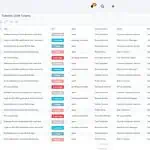
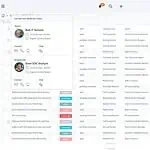
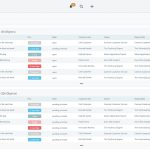
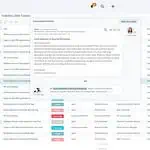
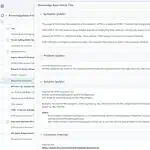
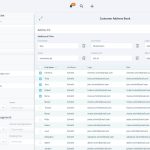
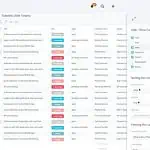
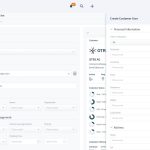

What Are the Benefits
of a Ticket System?
Better Communication Management
- Centralized management
- Status and communication
- Internal collaboration
- Duties and responsibilities
- Service categories for tickets
With centralized communication management via the ticket system, no messages get lost. The workload can be managed according to the volume of requests, priority, and availability of resources. The potential of the service team can thus be optimally utilized.
Various statuses can be assigned to a ticket. This allows you to see whether a ticket is still being worked on, whether it has been closed successfully, or whether it has a different status in the ticket overview.
When staffing changes occur or team collaboration is required to resolve a request, email communication can quickly become confusing because the communication thread is interrupted, or important information is missing. Follow up is then difficult or impossible.
With a ticketing solution, this problem does not exist. Every communication associated with the ticket is displayed chronologically in the ticket history. This makes it easy for a service employee to involve other departments or agents to handle requests.
This is a great benefit for support teams. Tickets can be processed by several employees and a handover is usually not required.
Within a ticket, it is possible for employees to exchange information that is not visible to the customer. In the event of a handover or a query within the departments, the message history of the ticket can be retained but hidden from the customer. This ensures that the customer only receives the information that he really needs.
A person responsible for resolving the ticket and a person in charge can be appointed for the ticket. This way, the responsible person always has an overview of the ticket and can delegate tasks for solving the ticket to other employees.
If the help desk or customer service team is divided into areas of responsibility or service-specific roles, only the tickets that fall within their service area are displayed for the service team members. This makes organization easier and improves the overview for the support employees.
Increase in Customer Satisfaction
Customers expect quick solutions to their inquiries. When this is provided, you stand out: Standing out positively from the competition is an opportunity that no company should miss. Faster responses increase customer satisfaction and thus customer loyalty.
Ticket automation, such as automatic ticket routing that allows tickets to be assigned to a specific employee based on a pre-defined skill matrix, speeds up the handling of requests.
Or, the status of a ticket could be automatically changed. This ensures, for example, that a ticket is answered or resolved within a certain period of time. If this doesn't happen, the automatic ticket status change can be triggered so that the team reacts quickly.
Processes ensure that workflows are adhered to, and these can be incorporated into the ticket system. By automating these, customers are guided through a process in an easy-to-follow way. Service managers become involved in the process at exactly the right time. This ensures consistent service quality and low administrative overhead.
More Efficient
Work
Compared to email, a ticket system has considerable advantages. With structured and clear assignment of incoming messages, the exchange of information in a central location is significantly easier, particularly when multiple parties are involved. Email quickly reaches its limits here. Even adding additional resources in the service department often does not bring the desired improvement in service quality when relying on email.
By classifying tickets, you create a better structure for the service team. Incoming tickets are distributed according to the required service or prioritization. Incoming requests are answered quickly and competently. Urgent requests can be reliably identified and given priority. Service level agreements (SLA) can be properly managed.
Rapid availability of information
With a knowledge database, customers can obtain information to solve problems on their own. This significantly reduces the number of incoming tickets. And, it means less wait time on the customer's side.
Employees also benefit from an internal knowledge base and knowledge base articles (KBA). Keywords assigned to the KBA automatically identify information about the ticket content and suggest it to the employee when they are writing a response. Employees can access information without leaving the ticket.
Continuous knowledge updates by employees
Best practices and useful information can be shared by employees to the knowledge base. Appropriate rights management ensures that knowledge shared by employees can be reviewed before it is published. This ensures service quality and prevents a proliferation of misinformation.
Optimization Through Reporting and Auditing
Comprehensive reporting is the foundation for successful service management. With integrated reporting functions, you have detailed insights into the performance of the service team.
Bottlenecks are identified at an early-stage and appropriate measures can be taken. For example, average response times as well as open and closed tickets can be retrieved. Escalation times are reliably recorded to ensure that service level agreements are met.
Revision security is becoming increasingly important today. The processing of tickets helps to optimize service quality. On the other hand, compliance guidelines must also be adhered to by the service team, and the continuity of a ticket is a means of proving such compliance.
Flexible Integration of Different Channels and Systems
Social media, messenger, live chat or telephone. In addition to email, different channels can be integrated into a ticket system. Using multiple channels to engage with customers significantly improves efficiency in customer service. In addition, the risk of siloed communication with customers and between departments in the company is reduced.
Other systems, such as a CRM, chat or merchandise management system, can be integrated via interfaces. Data can be exchanged between applications and data silos can be prevented.
Important Functions and Features of a Ticket System
A ticket system should have extensive functions and interfaces. This is the only way to ensure efficient service.
Customer Service & Self Service
Internet portal for self-service, service requests and provision of content, such as a knowledge database or FAQs
Knowledge management through a knowledge database, FAQ for customers and KBA for service employees
Search tickets, articles, service catalog or content based on various search criteria
Chat tool communication between the customer and the support team
Chat tool communication between service agents
Personalization & Management
Customize the agent's dashboard according to the needs of the employee, or preset it for the entire departments to draw quick attention to the most important information.
Controls to manage access, resources, and permissions
Allocation of tickets according to state, service, and urgency
Queue or list to which the ticket is assigned
Templates for recurring content and consistent communication
Customized databases for asset management with a CMDB
Asset management for compliance with maintenance cycles or for reporting equipment malfunctions
Service level management (SLM) for individual service level agreements between service recipient and service provider
Creation and management of available service options
Mobile access to all important functions with the OTRS app
Automation & Processes
Automation based on events, time, external systems and processes
The ability to define and manage processes from creation to completion through business process management software (BPMS)
Security & Reporting
End-to-end encryption of internal and external communications
Status, activities, services, SLAs, response, and escalation times
Ticket Systems and Their Areas of Application
The fact that a ticket system can be used in both IT service or customer service makes it clear that each use of a ticket system has its own requirements. A good ticket system is versatile and can be adapted according to the area of application. Functions can be combined to cover several business areas.
5 Tips for the Successful Implementation
For successful implementation of a ticket system in the company, thorough preparation is indispensable. This is the only way to take advantage of all the benefits of a ticket system and avoid costly planning errors.
Prepare the change process carefully. Involve all stakeholders in the company in order to be able to estimate the effort correctly.
- Where should the ticket system be used?
- Which departments can benefit from the use of the ticket system?
- What are the primary tasks?
- What requirements should the ticket system fulfill?
Describe workflows using diagrams so that the processes can also be precisely mapped later in the ticket system. In this way, additional effort and planning gaps are avoided.
Discuss complete requirements with the provider. An evaluation workshop with a consultant is money well spent. This can ensure that the ticket system really meets all requirements. In addition, the consultant can also provide support for optimizing the required processes.
Only with trained employees can the potential of the ticket system solution and the team be used optimally. Especially in the introductory phase, it is important to avoid frustration due to a lack of knowledge. Training can also significantly reduce the time it takes for the system to be used extensively.

FAQ
A ticketing system converts incoming messages into tickets. Each ticket has a unique number, category, status, and priority. Some ticketing systems also allow tickets to be assigned to items, such as a defective printer in the company or an item that has been sold to customers.
A ticketing system enables a more efficient organization of requests and a faster response. Tickets can be sorted and categorized according to their priority. Escalation times enable tickets to be answered or requests to be resolved within the defined period. The communication thread of the tickets remains throughout the communication process. This significantly increases the efficiency of processing requests.
